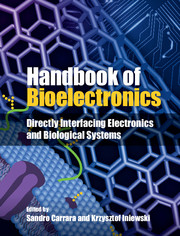Book contents
- Frontmatter
- Contents
- List of Contributors
- 1 What is bioelectronics?
- Part I Electronic components
- Part II Biosensors
- Part III Fuel cells
- Part IV Biomimetic systems
- 18 Biomimetic systems
- 19 Epidermal electronics – flexible electronics for biomedical applications
- 20 Bioelectronics brain using memristive polymer statistical systems
- 21 Electronic modeling of synthetic genetic networks
- Part V Bionics
- Part VI Brain interfaces
- Part VII Lab-on-a-chip
- Part VIII Future perspectives
- Index
- References
21 - Electronic modeling of synthetic genetic networks
from Part IV - Biomimetic systems
Published online by Cambridge University Press: 05 September 2015
- Frontmatter
- Contents
- List of Contributors
- 1 What is bioelectronics?
- Part I Electronic components
- Part II Biosensors
- Part III Fuel cells
- Part IV Biomimetic systems
- 18 Biomimetic systems
- 19 Epidermal electronics – flexible electronics for biomedical applications
- 20 Bioelectronics brain using memristive polymer statistical systems
- 21 Electronic modeling of synthetic genetic networks
- Part V Bionics
- Part VI Brain interfaces
- Part VII Lab-on-a-chip
- Part VIII Future perspectives
- Index
- References
Summary
One of the main advances brought about by the advent of synthetic biology is the design of artificial gene regulation networks that mimic the behavior of natural ones. This simplifies the analysis of cell behavior by isolating the relevant network motifs in a modular way. Consequently they can be studied independently of other complex cellular processes that in the natural case interfere with the motif of interest. This has been the main motivation behind the design of certain synthetic gene networks, such as oscillators and switches. In spite of their advantages, experimental studies of these synthetic systems are still difficult, owing both to the inherent complexity of molecular biology experiments and to our lack of knowledge of the kinetic parameters of the specific network components. Here we present a different modeling approach that makes sense in the context of electrical and electronic engineering. Genetic and electronic circuits share many aspects that can be interesting for the design and the analysis of synthetic networks.
Introduction
The climax of the genome project, of which the most notable success has been the complete sequencing of the human genome, is the knowledge of all the genes that compose the genetic material of an organism. The second phase of the project consists of the identification of its functional elements, which is the aim of the ENCODE project [1].
- Type
- Chapter
- Information
- Handbook of BioelectronicsDirectly Interfacing Electronics and Biological Systems, pp. 266 - 274Publisher: Cambridge University PressPrint publication year: 2015



